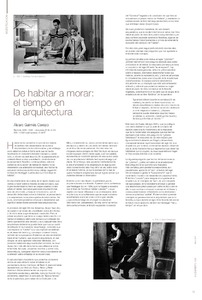Mostra el registre d'ítem simple
De habitar a morar: el tiempo en la arquitectura
| dc.contributor.author | Galmés Cerezo, Álvaro |
| dc.date.accessioned | 2017-05-03T18:46:46Z |
| dc.date.available | 2017-05-03T18:46:46Z |
| dc.date.issued | 2017-04 |
| dc.identifier.citation | Galmés Cerezo, Álvaro. De habitar a morar: el tiempo en la arquitectura. A: "Palimpsesto", Abril 2017, núm. 16, p. 15-17 |
| dc.identifier.issn | 2014-9751 |
| dc.identifier.uri | http://hdl.handle.net/2117/104013 |
| dc.description.abstract | El concepto de “Habitar” sufrió una importante transformación en el transcurso del siglo xx. La arquitectura de la modernidad ha estado muy preocupada por involucrar en su discurso muchos de los aspectos que emanan de este concepto. Aun así, ya bien entrado el siglo XXI, algunos de estos principios han quedado obsoletos.El presente artículo intenta poner al día el significado de habitar, buscando un vocablo que se adecúen mejor a lo que se entiende en la actualidad por esa acción ciudadana que repercute de un modo transcendente en la arquitectura y en especial en la vivienda.A través del vocablo “Morar” se establecen unos nuevos vínculos entre el individuo y su entorno, vínculos que van más allá del espacio y que se manifiestan en la relevancia que tiene el tiempo para la experiencia del morador. Por otro lado, se analizan las transformaciones que se han dado en aspectos relacionados con el “qué”, el “cómo” y el “donde” entre el antiguo termino de “habitar” y está nueva acepción. Por último, se redefine el concepto de “Morar” en para acercarse a las ideas del pensamiento fenomenológico actual. |
| dc.description.abstract | The concept of “inhabiting” has been one of the most influential ideas in the development of Modern Architecture. However, a hundred years after the beginning of that period, the premises that supported that notion have changed, which calls for a necessary revision of the concept. The present article analyzes the main ideas towards which this concept of inhabiting gravitated in the past, and how they have been subsequently replaced by new ones. According to that, it is necessary to redefine its meaning so that it adapts to the current thinking, as well as, in our opinion, to change its designation and replace the old term “inhabiting”, charged with a static and eminently functional connotation, with the term “dwelling”, which, due to its etymology, allows for a more up-to-date comprehension of that idea, by referring to the time factor as well as to diverse experiences of spatial interaction. |
| dc.language.iso | spa |
| dc.publisher | Cátedra Blanca de Barcelona |
| dc.rights | Attribution-NonCommercial-NoDerivs 3.0 Spain |
| dc.rights.uri | http://creativecommons.org/licenses/by-nc-nd/3.0/es/ |
| dc.subject | Àrees temàtiques de la UPC::Arquitectura |
| dc.subject.lcsh | Functionalism (Architecture) |
| dc.subject.lcsh | Space (Architecture) |
| dc.subject.other | Habitar |
| dc.subject.other | Morar |
| dc.subject.other | Tiempo |
| dc.subject.other | Inhabiting |
| dc.subject.other | Dwelling |
| dc.subject.other | Time |
| dc.title | De habitar a morar: el tiempo en la arquitectura |
| dc.title.alternative | From inhabiting to dwelling: time in architecture |
| dc.type | Article |
| dc.subject.lemac | Funcionalisme (Arquitectura) |
| dc.subject.lemac | Espai (Arquitectura) |
| dc.identifier.doi | 10.5821/palimpsesto.16.5196 |
| dc.identifier.dl | B. 7929-2013 |
| dc.description.peerreviewed | Peer Reviewed |
| dc.rights.access | Open Access |
| dc.date.updated | 2017-05-03T18:46:46Z |
| local.citation.publicationName | Palimpsesto |
| local.citation.number | 16 |
| local.citation.startingPage | 15 |
| local.citation.endingPage | 17 |
| local.personalitzacitacio | true |
Fitxers d'aquest items
Aquest ítem apareix a les col·leccions següents
-
16, Abril 2017 [11]
A RCR


